
Guide to Sichuan-Tibet Highway Southern Route via G318
Traveling from Sichuan Province to Tibet is one of the great road trips of China, on a route that covers over 2,200 kilometers, and passes some of the greatest sights of western Sichuan and Nyingchi in Tibet. There are two routes that can be taken to Lhasa, the northern and the southern routes, both of which start from Chengdu and have some of the most amazing scenery in the world.
Why Choose Sichuan-Tibet Highway Southern Route to Enter Tibet
The southern route of the Sichuan-Tibet highway is often deemed to be the more spectacular route, in terms of scenery, but is also considered to be very treacherous. However, with a little care and a good driver, the road is the perfect route to drive to get to Tibet.
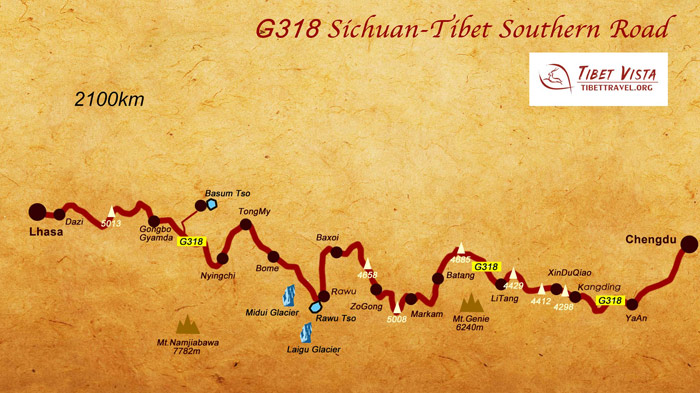 (Simple click to enlarge the map)
(Simple click to enlarge the map)
Sichuan Tibet Highway Southern Route Map
Considered to be the most beautiful scenic route to Tibet, the southern route is often used as a pilgrimage route to get to the holy city of Lhasa, the most revered city in Tibet, and the center of Tibetan Buddhism. Every day, Tibetan Buddhists from the western region of Sichuan set out on the 2,149 kilometer journey across the wild lands of western Sichuan and the beautiful valleys of Nyingchi, to reach the city of Lhasa, and the most sacred site in Tibet, the Jokhang Temple. And it is not only the devout Tibetan Buddhists who follow this path. In more recent years it has become a rite of passage for many Han Chinese youths, in search of a challenge and fulfillment that life in the modern, urban cities seems not to offer.
The spectacular scenery includes the beauty of the Yarlung Zangbo Grand Canyon and the snow mountain of Mount Gongga, not to mention the expansive Maoya Grasslands. The route also takes you through regions where the Kham culture is predominant, and gives you the chance to explore more of the Tibetan culture that can be found outside TAR, in places like Danba, Kangding, Xinduqiao, and Litang and Nyingchi.
Best Time to Enjoy Road Trip via G318 National Highway
While it would be nice to be able to drive this route all year round, there are certain times of the year when it becomes just too dangerous to drive. But for the rest of the year, the scenery changes with the seasons, and you can guarantee that, whatever time of year you succumb to the urge to drive along the highway, you will be treated to spectacular landscapes and scenery.
March to April
While most of Tibet is still under snow and quite cold, the climate in Nyingchi is already warm, and temperatures in March and April are warmer than they are further west. This gives rise to the splendid peach blossoms that cover the trees all over the region. Nyingchi is an area of wild forests, green pastures, and thousands of peach trees. Famous for its Peach Blossom Festival (mid-March to early April), driving the highway in the spring is one of the most amazing times of year to travel.
May to June
Another great time to drive the highway is in May and June, when the azaleas are blooming, and summer is under way. One of the best sites to see the beauty of the azalea flowers is at Sejila Mountain, in Nyingchi Prefecture. In total, there are around 25 species of azaleas in the 50 km section of the highway around Sejila Mountain, and the blooming of the azalea trees is a nationally recognized spectacle, bringing in thousands of tourists from all parts of China, as well as around the world.
July to August
As the year progresses into July and August, the entire length of the highway turns green, with lush grasses on the open pasture lands and the trees heavy with leaves. With the advent of summer, and the monsoon rains, the landscape comes alive with colors, as small prairie flowers bloom and cover the grasslands with a carpet of flowers. The weather is mostly warm, and though it will sometimes shower at night or for a couple of hours in the afternoon. It is not a big issue if you check the latest weather report before hitting the road. It is also the time for the horse racing festivals, and the most popular one along the highway is the Litang Horse Racing Festival in Kham Tibetan Area. This traditional Tibetan festival is held from August 1 to August 7 every year in Litang County, Sichuan Province, and is the most celebrated holiday in the Eastern Tibetan Plateau.
September to October
In September, the leaves start to turn yellow, as autumn takes a hold in western Sichuan and southeast Tibet. The rainy season is over, and the weather is still warm, making it one of the best times to travel along the highway. With the warm weather and less rain, it is the best time to take a side trip to see the famous snow mountain of Minya Konka, or Mount Gonggar, and the spectacular Hailuogou Glacier Park. Hailuogou Glacier Park has the most stunning glaciers in China, while the beauty of Minya Konka, the highest mountain in Sichuan province, is beyond compare. And then you have the beautiful area of unspoilt land in the world, Yala Snow Mountain. With its peak covered in snow all year round, Yala Kamiyama, situated at the juncture of Kangding, Danba and Daofu, is one of the four holy mountains of Garze Tibetan Autonomous Region of Sichuan Province and is considered very sacred by the local people.
November to February
From November to February, while there is still the chance to go trekking and sightseeing in both western Sichuan and the southeastern part of Tibet, it is really too cold and dangerous to travel along the highway. Winter has descended, and the roads are coated with snow, the temperatures often dip well below freezing, and many of the lodges and hostels along the route are closed. Now it is a wait until spring, when the snows thaw and the road opens up again to allow travelers and pilgrims to follow this epic, 2,149 kilometer journey to the roof of the world.
Insider Tips: As a common practice, from mid-Feb to whole March, Tibet is not available to international tourists. The high season of Tibet tour begins from April to Oct. And Nov to early Feb would be the off season.
Highlights of G318 Highway from Chengdu to Lhasa
Hailuogou Glacier and Springs
Hailuogou Glacier Forest Park is an integrative scenic area consisting of modern oceanic glacier, complete virgin forest, and boiling, hot, and cold springs. Located in Moxi Town of southwest Luding County, it sits on the east hillside of Mt. Gongga, the highest mountain in Sichuan.
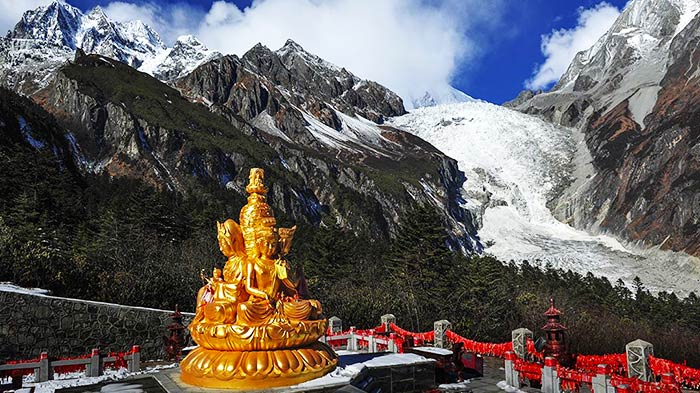 Hailuogou Glacier
Hailuogou Glacier
Xinduqiao
Xinduqiao is a picturesque small Tibetan town, famous for its plateau pasture scenery, vivid green grassland, streams, mountains, and Tibetan counting houses. Known as the “paradise of photographers” for its stunning scenery and perfect natural lighting, you are guaranteed to get some amazing photography done here.
.jpg) Xinduqiao
Xinduqiao
Mount Gongga
The highest mountain in Sichuan Province, Mount Gongga, or Minya Konka as it is known in Tibetan, is a must-see attraction, and for those with a sense of real adventure, a great spot for trekking. Minya Konka is a huge area, and there are several good trekking routes that you can use, and the routes almost all include the world renowned Minya Konka Monastery. Visited by the National Geographic reporter, Joseph Rock, the monastery also houses a sarcophagus that contains the remnants of a previous “living Buddha” of the monastery, which are now revered as sacred by the monks who visit.
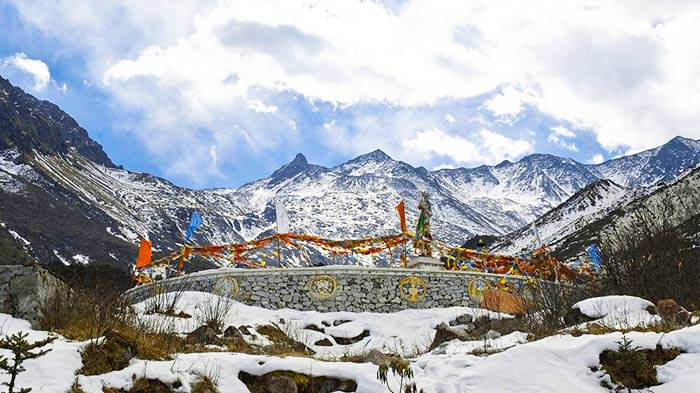 Mount Gongga
Mount Gongga
Yading
The Yading Nature Reserve in the Kham region of Sichuan is one of the most beautiful and popular places on the Tibetan Plateau. The reserve is the home to the three holy mountains of Chenrezig (6,032 meters), Chanadorje (5,958 meters), and Jambeyang (also 5,958 meters). These snow-capped peaks sit in a triangle formation with forested valleys, clear rivers, glacier-fed lakes and abundant wildlife between them.
 Yading
Yading
Haizi Mountain and Sister Lake
This amazing scenic area boasts unmatched natural beauty. It is typical Tibetan landscape, with beautiful striking blue lake and a natural hot spring sourced from the purest of natural mineral rich waters. Grand monasteries create a striking contrast with the barren empty landscape, punctuated only by towering mountains and imposing glaciers. Haizi Mountain and Sister Lake is a must-visit for all visitors to Daocheng County.
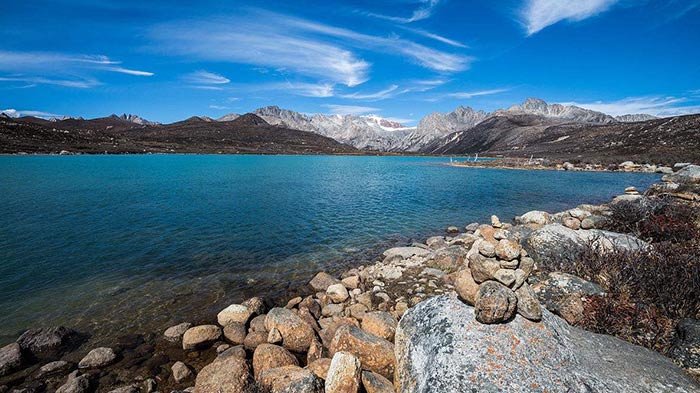 Haizi Mountain and Sister Lake
Haizi Mountain and Sister Lake
Maoya Prairie
Located in western Litang County of Ganzi Prefecture, Maoya Prairie is the largest area of grassland in the central Shaluli Range of the Hengduan Mountains. With an altitude between 3,800 meters and 4,500 meters, this boundless prairie is filled with wandering flocks and herds, and is the site of the famous Litang Horse Racing Festival.
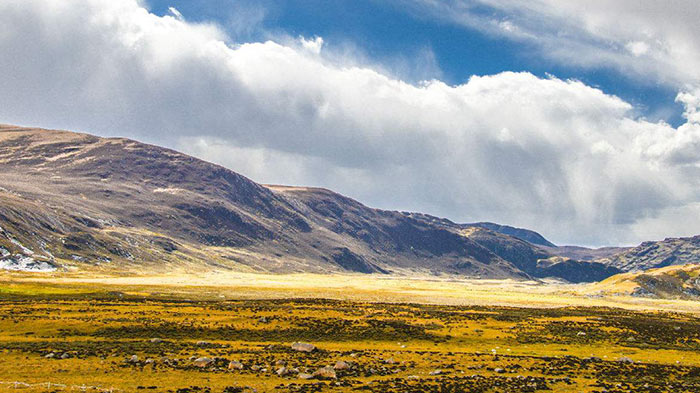 Maoya Prairie
Maoya Prairie
Lancang River Canyon
The upper reaches of the Mekong River in China is known as the Lancang River, and is one of the biggest rivers in Southwest China. China’s most beautiful grand canyon, the Lancang River Canyon is a 150 kilometer stretch of the river that cuts through the mountains from Foshan township to Yanmen township. On the left bank of the canyon lies Meili Snow Mountain, while on the right bank is the Baima Snow Mountain, and the slopes of the canyon are almost 14 kilometers long.
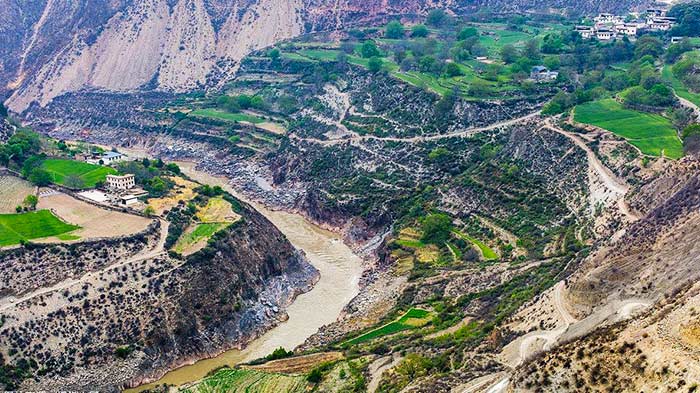 Lancang River Canyon
Lancang River Canyon
72 Turnings of Nujiang River
Many of the highways in China are miracles of modern construction, but the best has to be the part of the highway that meanders down the side of the Nujiang Mountain, in Baxoi County of Chamdo prefecture. This 12-kilometer long stretch of the highway switches back and forth, as it descends the mountainside, with sharp turns at each interval. With 72 turns along its length, drivers must take extreme care driving down this road, which culminates at the Nujiang River at the bottom of the mountain.
 72 Turnings of Nujiang River
72 Turnings of Nujiang River
Nujiang Grand Canyon
Part of the Nujiang River, not far from the Nujiang Mountain with its 72 turns, lies one of the most beautiful canyons in China. The Nujiang Grand Canyon is a spectacular, 315 kilometer long marvel of nature, with banks that reach as high as 3,000 meters. Nujiang is one of the most important rivers in China, and has carved out one fo the world’s most outstanding gorges in the Nujiang Grand Canyon.
 Nujiang Grand Canyon
Nujiang Grand Canyon
Ranwu Lake & Lagu Glacier
Ranwu Lake is a perfect blending of the Swiss Alps snow peaks and glaciers and the streams in Jiuzhaigou Valley. Ranwu Lake is the largest lake in Eastern Tibet, and is surrounded by Mt. Gangrigabu in the southwest, the Azhagongla Glacier in the south and the Bosula Peak in the northeast, with the famous Lagu glacier extending to the lake from the north.
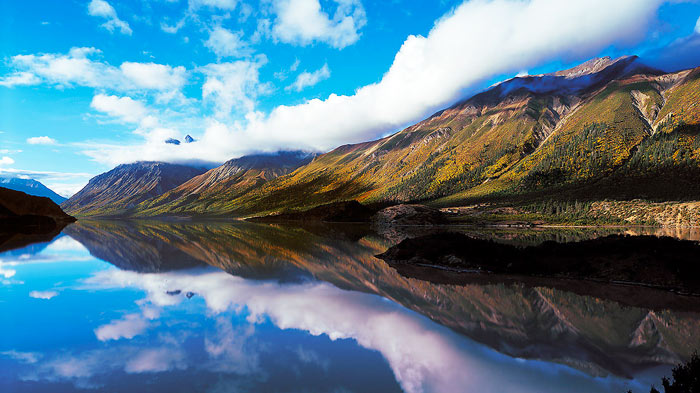 Ranwu Lake
Ranwu Lake
Namcha Barwa
Rising 7,782 meters above sea level, Namcha Barwa is the highest mountain in Nyingchi and ranks as the 28th highest peak in the world. The main holy mountain for Bonism, the oldest religion in Tibet, it is one of the most revered snow mountains in southeast Tibet. Reputed as the “Museum of Natural Vegetation”, Namcha Barwa has the most intact vertical vegetation zone in China, with evergreen and semi-evergreen tropical rainforests scattered in the river valley below.
 Namcha Barwa
Namcha Barwa
Midui Glacier
Located at Yupu Town, Midui Glacier is a typical maritime glacier in Tibet as well as the lowest glacier in the world with its snow line at just 4,694 meters high. Just eight kilometers off the G318 National Highway, Midui Glacier is a must-see tourist attraction for visitors driving to Tibet.
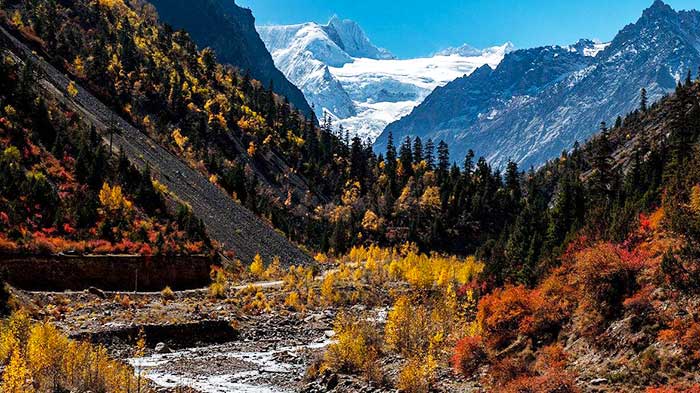 Midui Glacier
Midui Glacier
Lulang Forest
Lulang Forest is a typical plateau mountain meadow featuring stunning alpine scenery, located in Lulang Town, Nyingchi County. Nestled between the mountains and glaciers, it has an elevation of 3,700 meters, and consists of a vast expanse of plants, villages, and a wide variety of vegetation. In Tibetan, the name means “a place to forget your homesickness”, and that is really possible here, with its breathtaking landscapes, authentic rural scenery, and pure Tibetan lifestyle.
 Lulang Forest
Lulang Forest
Travel Documents
All foreign citizens need a Tibet Travel Permit to enter Tibet, and this can only be obtained by a registered tour operator. Once you have your Chinese Entry Visa, your tour operator will be able to book your itinerary, and apply for the Tibet Travel Permit. However, since Tibet has restrictions on foreign visitors traveling alone, they will also provide you with a guide for the entire trip along the highway, and on into Tibet, and obtain the Alien’s Travel Permit, which is necessary for traveling outside Lhasa, before you leave Sichuan. The Military Permit, for those wishing to visit sensitive areas such as Mount Kailash and Lake Manasarovar, is obtained by the guide once you are in Lhasa.
Packing List
When traveling to Tibet, it is important to know what things you should and should not bring. Some travelers like to take as little as possible when they go on a big journey, while others prefer to take as many comforts from home as possible. One thing is for sure, packing light is not the best thing to do. Tibet, and even the highway across western Sichuan, can get very cold at night, even in summer, so warm clothes are essential. If you are in a vehicle, you can use lighter clothing, since it is heated, but for excursions along the way, good, warm layers, a decent down jacket, weatherproof pants, and sturdy boots are necessary. Sunglasses and sunscreen are necessary once in Tibet, and may be useful against snow blindness if you are adventuring in the mountains of western Sichuan.
Unless you are specifically trekking in Sichuan or Tibet, a large backpack is not needed and not recommended, but a small backpack can be useful for day excursions to carry extra layers and essential items. Do not forget to pack any medication as well, as getting hold of medicines in western Sichuan.
Dining and Accommodation
Accommodation along the highway for foreign travelers with their guide is limited to the tourist-based hotels and hostels. While there are many other lodges and truck-stops along the road, which are used by cyclists and hitchhikers, they are off-limits to tourists. The best hotels along the route are normally in the major towns and cities, such as Kangding, Xinduqiao, Zuogong, and Bomi, with some smaller lodges and hostels designed for tourists as well, and the costs are much higher than for Chinese or Tibetans traveling the route.
Food is a mixture of Tibetan dishes and local Sichuan cuisine, though you can also find some western dishes on the menus at the hotels and hostels. If you are not a fan of either Tibetan or Sichuan cuisine, you should bring food with you, enough for the entire trip to Lhasa.

I am a tour guide in Tibet an was Born in Kham Tibet, I am the father of 2 little girls, bachelor's degree. I have more than 7-years experience of being a tour guide in Tibet. I am a warm, friendly, knowledgeable and attractive guy.


.jpg)



0 Comment ON "Guide to Sichuan-Tibet Highway Southern Route via G318 "